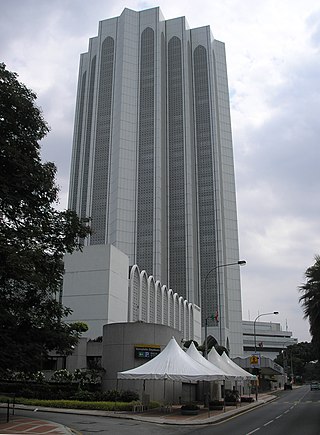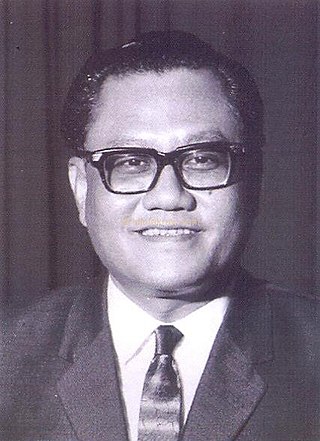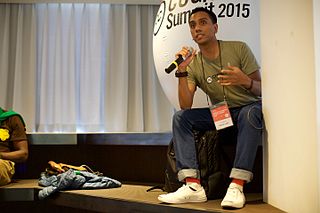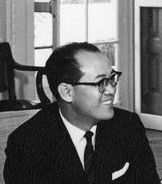
Kuala Lumpur, officially the Federal Territory of Kuala Lumpur and colloquially referred to as KL, is a federal territory and the ceremonial, legislative and judicial capital city of Malaysia. It is one of the fastest growing cities in Asia and the largest city in Malaysia, covering an area of 243 km2 (94 sq mi) with a census population of 1,982,112 as of 2020. Greater Kuala Lumpur, also known as the Klang Valley, is an urban agglomeration of 7.564 million people as of 2018. It is among the fastest growing metropolitan regions in Southeast Asia, both in population and economic development.

Tuanku Sir Abdul Rahman ibni Almarhum Tuanku Muhammad was the first Paramount Ruler or Yang di-Pertuan Agong of the Federation of Malaya, eighth Yang di-Pertuan Besar of Seri Menanti and second Yang di-Pertuan Besar of modern Negeri Sembilan.

Sultan Ismail Nasiruddin Shah ibni Almarhum Sultan Haji Zainal Abidin III Mu’azzam Shah was the fourth Yang di-Pertuan Agong of Malaysia and the sixteenth Sultan of Terengganu.

Alor Setar is the state capital of Kedah, Malaysia. It is the second-largest city in the state after Sungai Petani and one of the most-important cities on the west coast of Peninsular Malaysia. It is home to the third-tallest telecommunication tower in Malaysia, the Alor Setar Tower.

Independence Day, is the official independence day of Malaya from the British Empire. It commemorates the Malayan Declaration of Independence of 31 August 1957, and is defined in Article 160 of the Constitution of Malaysia. The day is marked by official and unofficial ceremonies and observances across the country.

The Sultan Abdul Samad Building is a late-nineteenth century building located along Jalan Raja in front of the Dataran Merdeka and the Royal Selangor Club in Kuala Lumpur, Malaysia. The building originally housed the offices of the British colonial administration, and was known simply as Government Offices in its early years. In 1974, it was renamed after Sultan Abdul Samad, the reigning sultan of Selangor at the time when construction began.


The National Mosque of Malaysia is a mosque in Kuala Lumpur, Malaysia. It has a capacity for 15,000 people and is situated among 13 acres (53,000 m2) of gardens. Its key features are a 73-metre-high (240 ft) minaret and a 16-pointed star concrete main roof. The umbrella, synonymous with the tropics, is featured conspicuously – the main roof is reminiscent of an open umbrella, the minaret's cap a folded one. The folded plates of the concrete main roof are a creative solution to achieving the larger spans required in the main gathering hall. Reflecting pools and fountains spread throughout the compound. Completed in 1965, the mosque is a bold and modern approach in reinforced concrete, symbolic of the aspirations of a then newly independent nation.


The Royal Museum along Jalan Istana was the former National Palace and former residence of the Yang di-Pertuan Agong of Malaysia. It stands on a 13-acre (50,000 m2) site, located on a commanding position on the slope of a hill of Bukit Petaling overlooking the Klang River, along Jalan Syed Putra.

Syed Thajudeen Shaik Abu Talib is a Malaysian painter. He is known for his large scale mural paintings of epic proportions set in period landscapes. A distinctive stylisation, romantic treatment of subject matter and the rich colours as in the Ajanta cave paintings of Maharashtra and of the Mughal are apparent in his works. This, together with the traditional visual arts' integral connection with literature, music, dance, sculpture and philosophy, helped shape Syed's early works. His works, as individualistic as they are, attempt to evoke a state of rasa, or heightened mood that belongs to a larger tapestry and sensibility of Asian artistic traditions. In many instances where his favourite subject matters deal with women and love, they share the same archetypal symbols and metaphors.

This article lists important figures and events in Malayan and Malaysian public affairs during the year 1963, together with births and deaths of significant Malaysians. The Federation of Malaya merged with Singapore, North Borneo, and Sarawak to form the Federation of Malaysia on 16 September.

This article lists important figures and events in Malaysian public affairs during the year 1984, together with births and deaths of notable Malaysians.

Singapore, officially the State of Singapore, was one of the 14 states of Malaysia from 1963 to 1965. Malaysia was formed on 16 September 1963 by the merger of the Federation of Malaya with the former British colonies of North Borneo, Sarawak and Singapore. This marked the end of the 144-year British rule in Singapore which began with the founding of modern Singapore by Sir Stamford Raffles in 1819. At the time of merger, it was the smallest state in the country by land area, but the largest by population.

Ungku Abdul Aziz bin Ungku Abdul Hamid was a Malaysian economist and lecturer. He was the 3rd Vice-Chancellor of the University of Malaya from 1968 to 1988 and the 1st General Director of the Council on Language and Literature of Malaysia from 1956 until 1957. He was awarded the title of Royal Professor in 1978.

Tan Sri Mohamed Khir bin Johari was a Malaysian politician and the former Malaysian Minister of Education.

Abdul Muid bin Abdul Latif was a Malaysian-based web designer, graphic designer and digital artist who is known for promoting the cultural elements of the Southeast Asia from Batik and Songket into his commercial works and artworks.

Tun Omar Ong Yoke Lin was a Malaysian politician, diplomat and businessman. He was a founding member of the Malaysian Chinese Association, and was a key figure in the country's road to independence. Ong served various positions in the government of Malaya and Malaysia, as a Cabinet minister and ambassador.

The Sabah Art Gallery is an art gallery in Kota Kinabalu, Sabah, Malaysia.
Ahmad Kamil bin Jaafar was a Malaysian politician and diplomat.




















